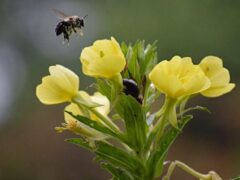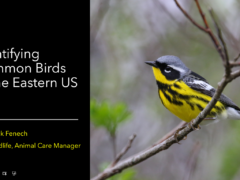The first thing to keep in mind is that baby birds, along with all other types of wild animals, have the very best chance of survival when left to be raised by their own parents. We wildlife rehabbers certainly try our best to raise orphans when there truly are no parents, but ultimately we can never recreate the lessons that an animal parent can [Read More …]
The Wonderful World of Bats!
Bats need our help now more than ever! A recent report determined that over 50% of our native bats are considered at risk. Besides adding diversity and flair to local wildlife, our bats consume countless pest insects every single night. These nocturnal neighbors need our help now more than ever. Bat Conservation International's Community Engagement [Read More …]
Urban Nature and Humane Health and Well-Being
In the minds of many people, urban areas and natural landscapes are considered to be mutually exclusive opposites. For city dwellers to experience nature, they have to leave the cities behind them and make a trek out to the country. But it is now becoming apparent that not only is it possible to have urban landscapes that afford people who live [Read More …]
Re-Nesting Baby Eastern Gray Squirrels
Baby wild animals have the best chance to survive and thrive when under the care of their parents. Wildlife rehabbers do all they can to care for and raise orphaned animals when no other options are available, but a rehabber should always be a last resort. However, a squirrel should be brought immediately to a licensed wildlife rehabilitator if [Read More …]
Restoring the darkness that restores the world
“How insupportable would be the days, if the night with its dews and darkness did not come to restore the drooping world.” Henry David Thoreau The hours when the earth is dark are frequently thought of as a time when not much of significance happens. But as certain Indigo Buntings demonstrated in the 1960s, that isn’t really true. It was known [Read More …]
From Rescue to Release: A Behind-the Scenes Look at Wildlife Rehabilitation
City Wildlife Clinic Director Dr. Sarah Sirica presents a behind-the-scenes look at what happens with wild animals after they are dropped off at our center. Using videos and photos taken during the course of our work, she demonstrates how we perform physical examinations, treat common injuries and illnesses, and care for patients, large and small, [Read More …]
Birds are migrating. You can help them!
Collisions with buildings kill more birds than any other human factor besides habitat loss and domestic cats, and in urban areas, the problem worsens during periods of migration. Researchers estimate that one billion birds die annually due to collisions with glass. Most neo-tropical songbirds migrate at night to avoid turbulence in the air and [Read More …]
Rat Poison Kills More Than Rats
It can start at the bird feeder, or maybe a public garbage can. Discarded food waste and garbage offer a smorgasbord for small rodents, who scavenge for a living. From there, it only makes sense that the animals who feed on those smaller animals, wild ones and feral or outdoor cats, are attracted secondarily. It’s a whole food chain, right in your [Read More …]
Bringing Back the Pollinators
Insect pollinators are an essential part of the food chain’s foundation, both for humans and for all other animals. They are necessary for the reproduction of over 85 percent of the world’s flowering plants, including more than two-thirds of the world’s crop species. Alarmingly, a 2019 study reports that 40 percent of all insect species are [Read More …]
Beginning Birding
On April 27, City Wildlife animal care manager, Dominick Fenech, presented an informative webinar for people interested in getting started in birding in the Washington, DC, area. Here is a link to his talk: [Read More …]
- 1
- 2
- 3
- 4
- Next Page »







